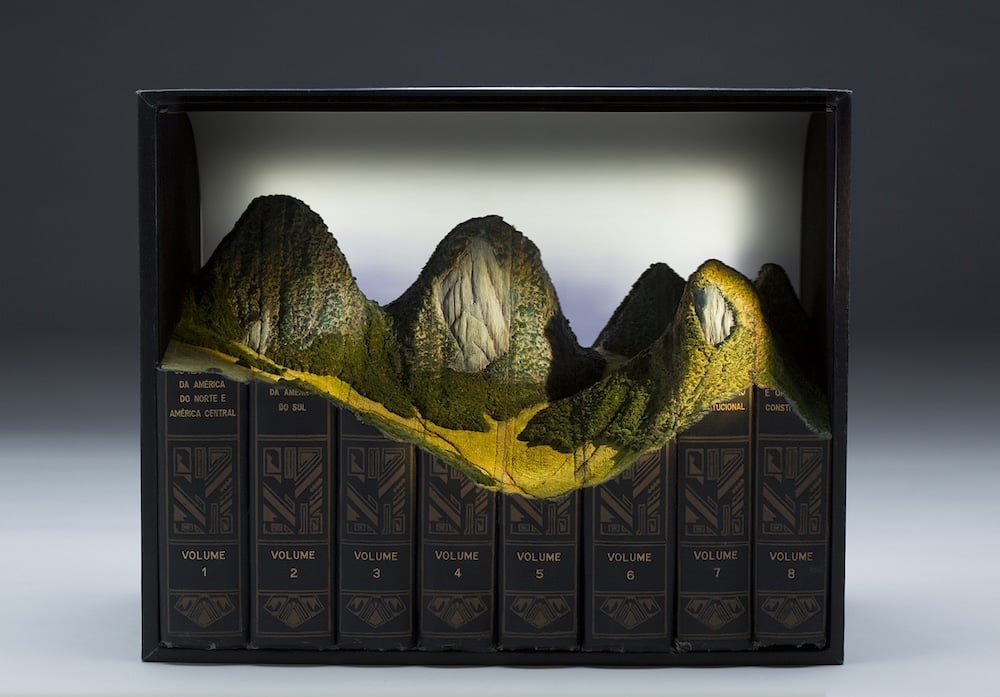Table of Contents
The Canadian artist who turns old encyclopaedias into picture-perfect landscapes using a sandblaster.
Contents
Guy Laramée’s book sculptures
Anthropology and art: a search for meaning
The erosion of culture
Guy Laramée is a Canadian artist who turns old books and encyclopaedias into meticulously detailed landscapes by employing a most unconventional technique.
He uses a sandblaster, a machine that shoots out a stream of compressed air and sand to polish or remove material from metallic or stone surfaces. Laramée places books in his sandblaster and “excavates” their pages, sculpting them into the form of landscapes, which he then finishes with paint.
He first had the idea of creating these incredible landscapes out of paper in 1999. Since then, he’s created dozens of pieces using this innovative technique.

Anthropology and art: a search for meaning
Laramée did not begin his career making art this way: in a career spanning 30 years, he has tried his hand at writing and directing plays, composing contemporary music, designing and building musical instruments, singing, making videos, screenwriting, sculpture, installations, painting and literature.
He has been awarded over 30 study grants and his work has been exhibited in the United States, Belgium, France, Germany, Switzerland, Japan and Latin America.

But it hasn’t all been plane sailing: “I was 42 and I was going back to school because, let’s face it, I was totally lost after 20 years of artistic career, mainly as a music composer. That life had come to a stop. It was impossible to continue,” Laramée explains in his TEDx talk.
The problem that Laramée had was with his artistic work. Once he finished a piece, he became despondent. Piece after piece, he was unable to find meaning, a central purpose or a theme in this work. He began to wonder: “Is the imagination a sickness?” Which led to more questions: What is the purpose of art? What is the purpose of life?

In his search for answers, he enrolled in two master’s degrees at the same time: one in anthropology, the other in visual arts. “In anthropology, I studied my cohort in visual arts, this very strange tribe of artists: imagination junkies. In visual arts, I studied my cohort in anthropology, this other very strange tribe of academics: knowledge junkies. I wrote a thesis – 350 something pages – but it can be summed up in one line: there is no real justification to art outside the actual practice of art.”
With this knowledge, he decided to do something that he admitted was “silly”.

“I was working in a metal shop and in one corner of the room there was a little sand blaster. Suddenly, I had a strange idea: what would it be like to put a book in that sand blaster? I had a book with me so I immediately went there, put the book inside, closed the door, started the machine, put my hands in the gloves, put the nozzle on the book and… bingo! Within seconds, the whole Biblios project unfolded. I saw the wind carving the dunes and cliffs. I saw civilisations being wiped out and recast into new ones. I saw culture returning to nature.”
The Biblios project is a series of pieces created using this technique. And underpinning Biblios is an overarching story that makes sense of it all, a story invented by Laramée himself: an ancient culture of people who live inside books. These people dug tunnels in books to connect words and acquire more knowledge. But at a some point, there were too many tunnels and the culture collapsed under the weight of all its knowledge. This metaphor lies at the heart of his work.

As well as the “Biblios” project, Laramée has produced many more pieces in the same vein, like “The Great Wall” and “Adieu“. In his work, he often critiques the ideology of progress, which is especially strong in Western culture.

The erosion of culture
The central theme these pieces is the “erosion of culture”. As Laramée explains:
“Cultures emerge, become obsolete, and are replaced by new ones. […] We are currently told that the paper book is bound to die. The library, as a place, is finished. One might ask so what? Do we really believe that “new technologies” will change anything concerning our existential dilemma, our human condition? And even if we could change the content of all the books on Earth, would this change anything in relation to the domination of analytical knowledge over intuitive knowledge? What is it in ourselves that insists on grabbing, on casting the flow of experience into concepts?”

His work stems from the idea that ultimate knowledge might come from erosion, rather than accumulation. And so the vast quantity of information spewed out by new technologies and communication methods is simply superfluous.
“So I carve landscapes out of books and I paint romantic landscapes. Mountains of disused knowledge return to what they really are: mountains. They erode a bit more and they become hills. Then they flatten and become fields where apparently nothing is happening. Piles of obsolete encyclopaedias return to that which does not need to say anything, that which simply IS. […] After 30 years of practice, the only thing I still wish my art to do is this: to project us into this thick “cloud of unknowing.”
The art of Guy Laramée reminds us that culture and knowledge are things that are valuable, worth looking after, but not to be greedily hoarded. His skill in turning old books into works of art invites us to reflect on how the information available to humanity is used. And, perhaps, on which of this knowledge should be kept and shared with future generations.

